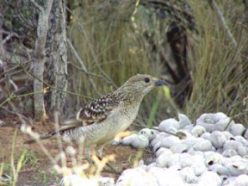A bowerbird’s guide to style
To attract a mate, male bowerbirds go for a cheaper, low-key look instead of showy decorations.
Most of us like to have something nice to wear on a first date. A new shirt, perhaps, or a pretty bracelet. We’re not alone. For some bird species, showing off their possessions is a strategy for attracting potential mates. The males of these species put shells, pieces of metal, and colorful berries on display. One species even favors objects that are blue.
 |
|
A male spotted bowerbird usually decorates his bower with white shells outside the entrance and a scattering of other keepsakes.
|
| R. Coe |
But, in a new study of spotted bowerbirds, biologists say that the males don’t put a high value on gathering rare treasures. Instead, the males tend to collect ordinary objects, such as twigs and common berries. And the females don’t seem to mind.
All this is part of the courting rituals of bowerbirds. Each male bird chooses a location, builds a structure, then decorates it. The result is a “bower,” a place for courtship.
The spotted bowerbird, which lives in Australia, uses sticks to build two parallel walls. He then adds decorations, such as berries, and waits for females to come by and check out his spot. The male does a song-and-dance routine when a female arrives and, if she likes what she sees, the pair will mate.
In their study of spotted bowerbirds, Joah R. Madden of the University of Cambridge and Andrew Balmford of the University of Sheffield, both in England, focused on 121 kinds of objects found in bowers. They already knew which of these objects were likely to signal a successful male.
The researchers wanted to find out whether the decorations that showed up in the bowers of the most successful males were common or rare. They surveyed the areas around bowers, counting how often they came across various objects.
Theories of bowerbird behavior had suggested that rare objects are more useful to males. If objects are hard to find or difficult to carry, this may send a signal to the female that the male is tough and resourceful. And that would make him a good mate.
This didn’t seem to hold true in Madden and Balmford’s study. A green berry was the top predictor of male success. And, in this study, green berries turned out to be readily available. So, the rarity of an object didn’t seem to affect a male bird’s chances of finding a mate.
It looks like male spotted bowerbirds have found a low-cost answer to their colorful dating game.







